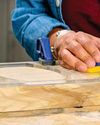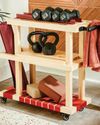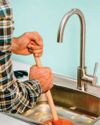يحاول ذهب - حر
BASEMENT FLOORING
March 2023
|Family Handyman
THE BEST MATERIALS AND PRACTICES FOR A MOISTURE-PRONE AREA

When you're choosing basement flooring, style and comfort matter, but your top consideration should be how well it can handle moisture.
As a starting point, you need to determine if there are any moisture issues in your basement. Obvious sources would be leaking pipes, water heaters, laundry tubs and floor drains, but there are also less obvious ones, such as moisture coming in through the foundation.
If you notice moisture entering through the foundation, you'll likely need to address the drainage around your home's exterior. Moisture coming in through the slab is less obvious; you'll need to run a test. Your flooring installer can do this for you, or you can perform the test on p. 53. If there's a moisture problem, the concrete must be sealed before you install any type of flooring.
The flooring you choose for a basement must be rated for below-grade installation. If you're not sure, check the product information and the manufacturer's website.

CARPET
Many people install carpet in basements because it makes the concrete floor warmer and more comfortable. That's a fine goal, but never make the mistake of installing carpet and underlayment directly on basement concrete. One reason is summertime mustiness. When humid summer air enters the carpet pile and comes close to the concrete underneath, that air can cool to the dew point, releasing fine droplets of water within the carpet or underlayment. That's why finished basements smell musty.
هذه القصة من طبعة March 2023 من Family Handyman.
اشترك في Magzter GOLD للوصول إلى آلاف القصص المتميزة المنسقة، وأكثر من 9000 مجلة وصحيفة.
هل أنت مشترك بالفعل؟ تسجيل الدخول
المزيد من القصص من Family Handyman

Family Handyman
Desktop Cord Organizer
Keep your devices charged and messy cords out of sight with this clever DIY box
3 mins
December 2025 / January 2026
Family Handyman
Custom Closet Storage
Turn any closet into a clutter-free zone with this easy organizer you can build in a day
3 mins
December 2025 / January 2026
Family Handyman
Entryway Storage
Keep on-the-go gear organized with a functional statement piece for your hallway, foyer or mudroom
8 mins
December 2025 / January 2026

Family Handyman
Lazy Susan
This rotating tray fit for a feast displays your craftsmanship from all angles
4 mins
December 2025 / January 2026

Family Handyman
Handy Hints
An organized workshop makes every project run smoother. Check out these smart solutions for taming clutter.
1 mins
December 2025 / January 2026

Family Handyman
New Year, New Gym
Kick off 2026 with a home workout space that energizes and inspires you. Start here for an easy DIY to keep your gear organized, then explore ideas for quick upgrades that refresh the room.
3 mins
December 2025 / January 2026

Family Handyman
DIY Kegerator
Keep the cheer flowing with frosty pours on demand
5 mins
December 2025 / January 2026

Family Handyman
Keep Your Kitchen Flowing
The sink, garbage disposal and dishwasher are interconnected. Use these tips and simple fixes to stop slowdowns.
6 mins
December 2025 / January 2026

Family Handyman
The Art of What's Left Behind
In a country that trashes more than 12 million tons of furniture every year, one resourceful woodworker is proving there's beauty—and a business—in the scraps
3 mins
December 2025 / January 2026
Family Handyman
Great Goofs
DIY projects don't always go as planned. These readers learned the hard way!
1 min
December 2025 / January 2026
Translate
Change font size
